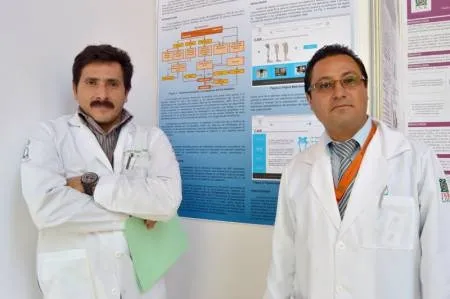Diabetes is a chronic disease that can present a series of complications in people who suffer from it, for example, nerve injuries or blood vessel.
According to Heriberto Aguirre Meneses and Marco Antonio Núñez Gaona, researchers from the Department of Technological Development and the Subdirectorate of Technological Research of the National Institute of Rehabilitation (INR), 70 percent of the cases of diabetic patients who are hospitalized at the end of the Institutewith an amputation of the lower extremities.
Due to the lack of previous care associated with this condition, the reamping usually occurs.In 2014 alone, 202 revenues of amputated patients were presented, of which 35 percent was for metabolic cause.Due to the conditions of these patients there is a high degree of abandonment of institutional therapies, this according to specialists.
With this background, INR researchers (from the aforementioned departments) work on the development of a computer medical computer -assisted rehabilitation system, with technological tools necessary to support the treatment of amputated diabetic patients.
It is then a comprehensive care proposal to the amputated diabetic patient whose function is to contribute to the fact that it performs its distance treatment (Telerrehabilitation) and that it can be visualized by a web browser on mobile devices such as an electronic cellular or tablets.
The INR proposal presents three rehabilitation levels: Health hygiene section, risk reduction section and monitoring and attachment section, to help the patient in the placement of their prostheses and subsequent treatment, all through multimedia elements.
(Photo: Conacyt)
One of the tools that includes this development is videoconference or online chat, which will help patients solve doubts about their therapy and know if it is done properly.
Based on a controlled session, the information obtained in each of these consultations will allow the doctor to follow up the treatments and even change them if he considers it.
According to previous studies conducted by researchers, the attachment of patients has been determined to treatment based on the use of ICT (information and communication technologies), thus concluding their treatment.
According to Heriberto Aguirre Meneses, a specialist in medical computer science and image processing, with the traditional method the patient must go to the facilities of the Institute for its clinical review, have a preprothetic and post -surgical training to carry out their disease as much as possible.However, they generally abandon their treatment due to factors such as time, effort and money for transfer and that is that a large percentage of them comes from different states of the country.
“In the institute the patient receives initial training so that he can carry out the subsequent activities in his home through this platform he can access through a custom user and password.Based on the patient's clinical background, as well as the rehabilitation process itself, the doctor follows continuous and personalized to prescribed therapy, ”said the medical science researcher.
Among the purposes of the research group is to reduce the complications associated with diabetes related amputation.Aguirre Meneses stressed that the importance of this type of systems lies in bringing health services to the patient so that they can access therapiesPersonalized and endorsed by medical specialists through health care and hygiene implemented on the platform.
“The use of ICT is constantly evolving and statistics currently indicate that 85 percent of the population uses an electronic device;Approach health services to patients through applications that are mounted on a server and that can be accessed by mobile devices, facilitates work, time and cost.In the very close future we can use auxiliary tools in health processes, ”he concluded.
The project is currently in the clinical analysis stage.So far development architecture has access to content such as images, videos and support texts for treatment.(Source: Carmen Báez/(Conacyt Information Agency)


